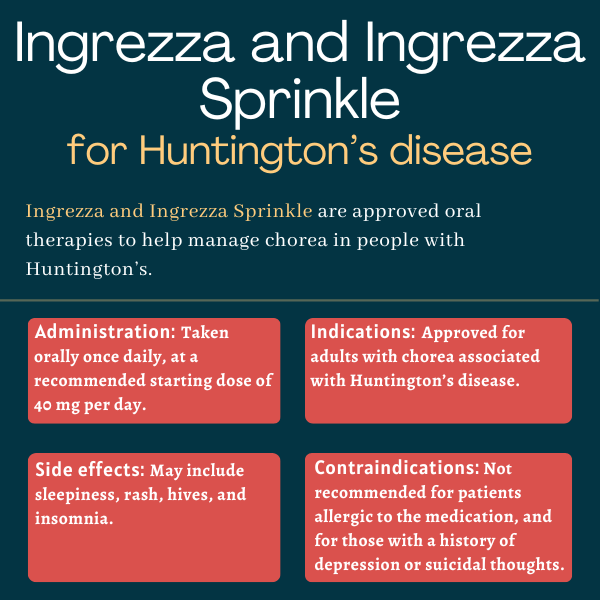Ingrezza and Ingrezza Sprinkle (valbenazine) for Huntington’s disease
Last updated May 3, 2024, by Marisa Wexler, MS

What is Ingrezza for Huntington’s disease?
Ingrezza (valbenazine) is an oral medication approved in the U.S. to ease the involuntary, jerky movements known as chorea that are observed in most people with Huntington’s disease.
The medication originally came in capsules that had to be swallowed whole, but a granulated formulation called Ingrezza Sprinkle, which is designed to be sprinkled over soft food for patients with swallowing difficulties, is now also available in the U.S.
Developed by Neurocrine Biosciences, both formulations are also approved for adults with tardive dyskinesia, a movement disorder marked by facial tics.
Therapy snapshot
| Brand name: | Ingrezza and Ingrezza Sprinkle |
| Chemical name: | Valbenazine |
| Usage: | Used to ease chorea associated with Huntington’s |
| Administration: | Oral capsules, swallowed whole, or opened and sprinkled onto soft food |
How does Ingrezza work?
Huntington’s is an inherited, progressive neurodegenerative disease characterized by motor and nonmotor symptoms. The most notable motor sign is chorea, which affects about 90% of Huntington’s patients and is evident by its involuntary and uncontrollable movements.
Chorea can affect several parts of the body and negatively impact motor coordination, walking ability, and posture, as well as swallowing and speech.
Huntington’s-associated chorea is thought to be associated with unusually high levels of dopamine, a major brain chemical messenger, or neurotransmitter, that plays key roles in coordinating movement.
Valbenazine, the active agent in Ingrezza and Ingrezza Sprinkle, is a small molecule that potently and selectively blocks the activity of a protein called vesicular monoamine transporter 2, or VMAT2. This protein is responsible for neurotransmitter transport and recycling at the synapse, which is the point of near contact between nerve cells where they release molecules to communicate with each other.
While valbenazine’s precise mechanism of action isn’t fully understood, its ability to suppress VMAT2 is thought to reduce the amount of dopamine that’s released by nerve cells at the synapse. That, in turn, is believed to dial back activation of neighboring nerve cells. By lowering dopamine signaling in the brain, the therapy is expected to reduce chorea in patients.
Who can take Ingrezza?
Ingrezza was approved by the U.S. Food and Drug Administration (FDA) in August 2023 for adults with chorea associated with Huntington’s. The decision made Ingrezza the first approved VMAT2 suppressor to offer an effective starting dosage that can be adjusted based on response and tolerability, without complex dose optimization, according to Neurocrine.
The FDA later extended its approval in April 2024 to include an oral granulated formulation called Ingrezza Sprinkle. Currently, neither version of the medication is approved in any other countries for Huntington’s-associated chorea.
Who should not take Ingrezza?
Ingrezza and Ingrezza Sprinkle are not recommended for patients with a known allergy to valbenazine or any other ingredients in the medications.
The medications’ combined label also carries a boxed warning noting it may increase the risk of depression and suicidal thoughts in people with Huntington’s, so caution is recommended when treating individuals with a history of depression, suicidal thoughts, or suicide attempts.
The therapies should not be taken in combination with medications that are strong CYP3A4 inducers, such as the antibiotic rifampicin. CYP3A4 is a liver enzyme that’s key for the metabolism of many medications.
Patients on monoamine oxidase (MAO) inhibitors, a type of antidepressive medication, should avoid taking Ingrezza or Ingrezza Sprinkle simultaneously and during the first two weeks after discontinuing their MAO inhibitor treatments.
Ingrezza and Ingrezza Sprinkle should also be avoided in patients who have certain types of abnormal heart rhythms.
How is Ingrezza administered in Huntington’s disease?
Ingrezza and Ingrezza Sprinkle are available in the form of oral capsules that can be taken with or without food. Ingrezza capsules, designed to be swallowed whole, exist in three dose strengths:
- 40 mg capsules, which have a white opaque body and purple cap, both printed with “VBZ” and “40” in black ink
- 60 mg capsules, with a dark red opaque body and purple cap, both printed with “VBZ” and “60” in black ink
- 80 mg capsules, which have a purple opaque body and cap, and are printed with “VBZ” and “80” in black ink.
Ingrezza Sprinkle capsules may be swallowed whole or opened to sprinkle its contents onto soft foods. Available in three dose strengths, the medication comes in pearl white opaque capsules printed with a band and directional arrows:
- 40 mg capsules, printed with “VBZ 40” in black ink on both the cap and body
- 60 mg capsules, printed with “VBZ 60” in dark red ink on both the cap and body
- 80 mg capsules, printed with “VBZ 80” in purple ink.
The recommended starting daily dose of either Ingrezza formulation is 40 mg per day. After two weeks, the dose can be upped to 60 mg/day, and then after another two weeks, it can be increased to the recommended maintenance dose of 80 mg once daily.
Lower maintenance doses — specifically of 40 or 60 mg/day — may be considered based on a patient’s response to treatment and ability to tolerate the medication.
The dosage should be reduced to 40 mg per day in patients who:
- have moderately to severely impaired liver function
- are known to have poor activity of CYP2D6, another liver enzyme that’s involved in the metabolism of several medications
- are taking medications that are strong suppressors of CYP3A4 or CYP2D6.
When not swallowed whole, the entire contents of an Ingrezza Sprinkle capsule should be sprinkled over and mixed with about a teaspoon of soft food such as yogurt, pudding, or applesauce, and swallowed immediately. If needed, the mixture may be stored at room temperature for up to two hours, but any unused mixture should be discarded thereafter.
After swallowing the mixture, patients should drink a glass of water. The contents of Ingrezza Sprinkle should not be mixed with a liquid such as milk or water, nor should it be administered via a feeding tube because it can cause obstructions.
Ingrezza capsules should be stored at room temperature (15 to 30 C or 59 to 86 F). The range of optimal storage temperature for Ingrezza Sprinkle is shorter (20 to 25 C or 68 to 77 F) and the capsules should be stored in a container that is protected from moisture. Ingrezza Sprinkle capsules should not be crushed or chewed.

Ingrezza in clinical trials
The FDA’s approval of Ingrezza for Huntington’s-associated chorea was based mainly on data from a Phase 3 clinical trial called KINECT-HD (NCT04102579), completed in October 2021.
KINECT-HD
The KINECT-HD study enrolled 128 adults with chorea related to Huntington’s at 46 sites across North America. Participants were given an oral capsule of either Ingrezza or a placebo, once daily for 12 weeks, or about three months. The therapy was started at a daily dose of 40 mg and gradually increased to 80 mg/day based on tolerability.
The trial’s main goal was to evaluate changes in chorea severity, as assessed with the Total Maximal Chorea score of the Unified Huntington’s Disease Rating Scale. This measure evaluates chorea in the face, mouth/jaw, trunk, and each limb, with higher scores indicating worse chorea.
The results showed that, on average, chorea scores dropped by 4.6 points in Ingrezza-treated patients and by 1.4 points in those given the placebo — a more than three-point difference that was statistically significant. After three months, nearly half of patients on Ingrezza had experienced a reduction in chorea severity of more than 40%.
Reductions in chorea scores were seen as early as two weeks after patients started on Ingrezza. Also, considerable improvements in overall health were significantly more common in the Ingrezza group than among those on the placebo, as reported by patients (43% vs. 13%) and by clinicians (53% vs. 26%).
KINECT-HD was the first Phase 3 trial to use a new validated measure of patient-reported disease burden in Huntington’s. This measure is called the Huntington’s Disease Health Index. Results using this assessment confirmed Ingrezza’s superiority over the placebo, with the medication leading to a greater reduction in disease burden associated with uncontrolled movements, mobility problems, and hand and arm dysfunction.
Ongoing trials
An open-label extension study called KINECT-HD2 trial (NCT04400331) is evaluating the long-term safety and efficacy of Ingrezza in adults who have chorea due to Huntington’s.
The trial was open to patients who completed the KINECT-HD study and to other adults with Huntington’s-associated chorea. All participants are receiving the therapy for up to three years.
Interim data have indicated that the chorea-reducing effects of Ingrezza are maintained up to at least one year of treatment, and that these effects are not affected by simultaneous use of antipsychotic medications.
Ingrezza Sprinkle in clinical trials
Ingrezza Sprinkle’s approval was supported by the same data from KINECT-HD, plus information about its manufacturing, chemistry, and bioequivalence to Ingrezza, with the new formulation showing similar movements into, through, and out of the body, and resulting in comparable drug exposure.
Common side effects of Ingrezza
The most common side effects of Ingrezza and Ingrezza Sprinkle in people with Huntington’s include:
- sleepiness, lethargy, or sedation
- hives (urticaria)
- rash
- insomnia.
Depression and suicidal thoughts
The label for Ingrezza and Ingrezza Sprinkle carries a boxed warning noting the medications may increase the risk of depression and suicidal thoughts or behaviors in people with Huntington’s, who are already at risk.
Before starting Ingrezza or Ingrezza Sprinkle, patients and their healthcare team should discuss whether the need for treatment outweighs the risk of depression and suicidal thoughts.
Those starting on the therapy or who change their dose should be closely monitored for new or worsening signs of these issues. Patients, caregivers, and family members should be aware of this risk and report sudden changes in mood, behaviors, thoughts, or feelings to the treating physician.
If patients show new or worsening signs of depression, or suicidal thoughts and/or behaviors that do not resolve, stopping Ingrezza should be considered.
Allergic reactions
Ingrezza and Ingrezza Sprinkle may cause allergic reactions, including rash, hives, and tissue swelling that can be life-threatening if it affects the throat and blocks the airways. Either treatment should be stopped if an allergic reaction occurs, and patients should seek immediate medical care if they experience any swelling symptoms.
Drowsiness and sedation
Sleepiness, also known as somnolence, and sedation were the most commonly reported side effects of Ingrezza in clinical trials. It is recommended that people starting on Ingrezza or Ingrezza Sprinkle avoid driving, operating heavy machinery, or doing other activities that require alertness until they know how the medication affects them.
Abnormal heart rhythms
Ingrezza and Ingrezza Sprinkle can cause a change in heart rhythm known as QT prolongation. These changes are not usually clinically significant at the therapy’s recommended dose, but may become so in people taking strong CYP2D6 or CYP3A4 inhibitors, or in those with poor CYP2D6 activity.
The therapies should not be given to patients with a syndrome associated with QT prolongation or with heart rate abnormalities characterized by QT prolongation. For patients at increased risk of these abnormalities, their heart rhythm should be assessed before starting treatment or increasing their daily dosage.
Neuroleptic malignant syndrome
Ingrezza, Ingrezza Sprinkle, and other therapies that work by blocking VMAT2 can cause a life-threatening neurological disorder called neuroleptic malignant syndrome, or NMS, which is marked by high fever, rigid muscles, an altered mental state, and heart rhythm and blood pressure abnormalities.
If NMS occurs, Ingrezza or Ingrezza Sprinkle should be discontinued immediately, and patients should be given intensive medical care to manage any symptoms. If either medication is restarted, patients should be monitored for signs of NMS recurrence.
Parkinson’s-like symptoms
Ingrezza and Ingrezza Sprinkle may cause symptoms similar to those seen in Parkinson’s disease. These symptoms, known as parkinsonism, include slowed movement (bradykinesia), tremor, rigidity, and problems with balance.
If patients develop clinically significant parkinsonism while on Ingrezza or Ingrezza Sprinkle, the dose should be reduced or the treatment stopped.
Use in pregnancy and breastfeeding
Not enough data are available to make robust conclusions about the safety of Ingrezza or Ingrezza Sprinkle when used in patients who are pregnant or breastfeeding. However, animal data suggest the medications may harm a developing fetus and/or nursing infant, as administering valbenazine to rats from pregnancy through lactation led to an increase in the number of stillborn pups.
Patients who are pregnant or plan to become pregnant should consult with their healthcare team and carefully weigh the potential benefits and risks of using Ingrezza or Ingrezza Sprinkle.
The presence of the medication in human breast milk and its potential effects on a breastfed infant or on milk production in nursing patients remain unknown. Still, patients are advised not to breastfeed while taking Ingrezza or Ingrezza Sprinkle and for at least five days after stopping treatment.
Huntington’s Disease News is strictly a news and information website about the disease. It does not provide medical advice, diagnosis, or treatment. This content is not intended to be a substitute for professional medical advice, diagnosis, or treatment. Always seek the advice of your physician or other qualified health provider with any questions you may have regarding a medical condition. Never disregard professional medical advice or delay in seeking it because of something you have read on this website.
Recent Posts
- Antipsychotics improve functional capacity, independence in HD
- Despite dwindling resources, hope endures among researchers
- The ‘invisible’ symptoms of Huntington’s that people don’t see
- Genetic variant delays Huntington’s onset by up to 23 years: Study
- Watching Huntington’s switch roles in our marriage was jarring
- The gift of community is what I’m most thankful for this year
- Revir wins $4.6M grant to advance oral Huntington’s treatment
- The inheritances that shape how we love, lead, and live
- Listening to my body without shame when it says, ‘Rest’
- Fatty molecules help brain cells remove Huntington’s faulty protein
Related articles




